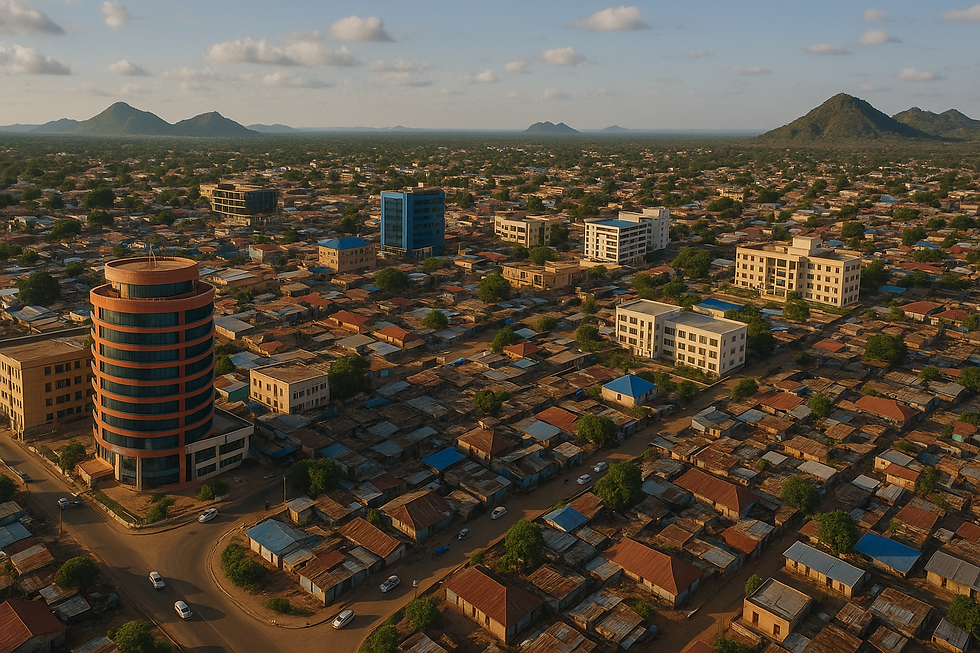Luxembourg’s ESG Ambition: A Financial Microstate Goes Green and Global
- tinchichan

- Jul 30
- 5 min read
Tucked between France, Germany, and Belgium, Luxembourg is often underestimated by its size and overestimated by its wealth. Yet in the fast-evolving world of sustainable finance, the Grand Duchy is doing something quietly revolutionary: leveraging its financial ecosystem to become a global ESG hub.
Already a European leader in cross-border fund administration, Luxembourg is now betting on green finance, social innovation, and governance modernization to stay ahead. Its strategy is less about industrial decarbonisation—there’s little heavy industry to begin with—and more about regulatory agility, data transparency, and financial diplomacy.

“We may be small, but we aim to be a multiplier,” says Yuriko Backes, Luxembourg's Minister of Finance. “Our ESG strategy is about connecting capital to purpose—and doing it credibly.”
1. A Microstate with Global Financial Reach
Despite its population of just 660,000, Luxembourg is:
The world’s second-largest fund domicile, after the US
Europe’s leading hub for cross-border investment funds (€5.6 trillion in assets under management as of Q2 2024)
Home to over 4,000 investment funds, many of which now fall under ESG regulation
This gives Luxembourg outsized influence in shaping sustainable finance norms, especially in Europe—but also globally, through its partnerships with Africa, Asia, and Latin America.
2. Environmental Policy: Decarbonization Without Deindustrialization
2.1 Climate Targets and Energy Transition
Luxembourg has committed to:
Climate neutrality by 2050
55% GHG emissions reduction by 2030 (compared to 2005 levels)
Achieving 25% renewable energy share by 2030
Progress is mixed:
GHG emissions fell 24.2% between 2005 and 2023, but transport remains a major emitter, due to cross-border commuting and fuel tourism
Renewables account for only 11.7% of final energy consumption, one of the lowest in the EU (Eurostat, 2023)
The government plans to phase in solar PV, wind, and green hydrogen, but faces land constraints and grid congestion
2.2 Climate Finance Leadership
Where Luxembourg excels is in climate and ESG finance:
Created the Luxembourg Green Exchange (LGX) in 2016—the world’s first platform dedicated exclusively to sustainable securities
LGX hosts over 1,400 green, social, and sustainability bonds from 200+ issuers across 50+ countries
Total capital raised through LGX exceeds €900 billion, with growing interest in transition and biodiversity-linked bonds
“Luxembourg does not compete on emissions reductions—it competes on capital mobilisation,” says Julie Becker, CEO of the Luxembourg Stock Exchange. “That’s where we add global value.”
3. Social Inclusion: Small State, Big Gaps
3.1 Prosperity with Pressure
Luxembourg boasts the highest GDP per capita in the EU (~€115,700 in 2023), but that figure masks:
Rising income inequality: Gini coefficient at 0.35
Housing unaffordability, especially in Luxembourg City, where prices rose +77% since 2015
A workforce where 46% are cross-border commuters, leading to social-policy complexity
The government has responded with:
A €2.5 billion affordable housing plan (2022–2027)
Expansion of childcare subsidies and minimum income
ESG-linked public procurement for infrastructure and social services
Still, NGOs argue that social ESG metrics lag behind financial innovation, and data transparency on equity and inclusion is limited.
4. Governance: Regulatory Depth with ESG Evolution
4.1 ESG Regulation and Supervision
Luxembourg has moved fast to align with EU-level ESG rules:
Implements all major EU ESG frameworks: SFDR, CSRD, EU Taxonomy, and Benchmarks Regulation
The Commission de Surveillance du Secteur Financier (CSSF) enforces ESG disclosures for investment firms and funds
The Luxembourg Sustainable Finance Initiative (LSFI) provides ESG tools, guidance, and training for asset managers
In 2023:
Over 60% of Luxembourg-domiciled funds qualified as Article 8 or 9 under SFDR
CSSF conducted its first ESG audit inspections, focusing on greenwashing risk and due diligence quality
4.2 Corporate Governance and Accountability
The Luxembourg Stock Exchange introduced ESG reporting guidelines for listed companies in 2022
The Luxembourg Business Registers began publishing beneficial ownership data in open format
But board diversity remains limited—only 27% of board seats in listed companies are held by women (2023)
5. ESG Capital Markets and Financial Innovation
5.1 Luxembourg Green Exchange (LGX): A Case Study in Global ESG Finance
The LGX is at the heart of Luxembourg’s ESG strategy:
Hosts nearly half of all green bonds issued by sovereign and supranational institutions worldwide
Supports ESG investment standards including ICMA Green Bond Principles, EU Taxonomy, and CBI Certification
Partnered with UNDP and IFC to develop sustainability bond frameworks for emerging markets
In 2023, LGX launched:
The LGX DataHub, a digital platform offering ESG data on over 10,000 issuers
A transition finance window to support hard-to-abate sectors like shipping and steel
“We want LGX to be not just a listing venue—but a trust platform,” says Becker. “Transparency is our product.”
6. ESG in Asset Management and Investment Funds
6.1 Fund Industry Integration
As of 2024, €2.1 trillion in Luxembourg-domiciled funds are classified as Article 8 or 9
Key players include Amundi, Pictet, and Nordea, using Luxembourg as a base to distribute ESG funds across the EU
Specialized ESG funds include climate equity, biodiversity, social housing, and green private debt
6.2 ESG Fintech and Startups
Luxembourg’s startup ecosystem is growing in ESG analytics:
Sustained Analytics: ESG data for private markets
Impakt.io: AI-based ESG compliance tools for SMEs
Greenfintech Forum launched in 2023 to incubate ESG-focused startups with backing from the Ministry of the Economy
7. International ESG Partnerships and Diplomacy
Luxembourg is one of Europe’s most active ESG donors and facilitators:
Contributes to climate finance via the International Climate Finance Accelerator (ICFA)—supporting over 25 impact fund managers from the Global South
Co-launched the Sustainable Finance Disclosure Dialogue with Rwanda and Togo
Partners with EIB, UNDP, and GGGI on green bond standards, ESG fund capacity building, and gender-smart investing
“We see ESG not just as a regulation—but as a tool for global development,” says Romain Schneider, former Minister for Development Cooperation.
8. ESG Performance and Positioning
Indicator (2023) | Luxembourg | Ireland | Netherlands | Switzerland |
GDP per capita (€) | 115,700 | 91,200 | 63,400 | 89,400 |
Renewable share (%) | 11.7% | 13.5% | 27.3% | 19.8% |
Green bond issuance (€) | 900bn (via LGX) | 12bn | 32bn | 20bn |
Article 8/9 fund share | 61% | 49% | 53% | 45% |
Transparency Int. Rank | 9/180 | 10/180 | 8/180 | 7/180 |
*Luxembourg leads on financial ESG integration, but trails on energy transition and social equity.
9. Strategic Priorities and Risks
Challenges
Limited domestic decarbonisation options due to economic structure
Housing and inequality pressures in a high-cost economy
Risk of regulatory arbitrage as ESG rules tighten across the EU
Greenwashing scrutiny from EU regulators and NGOs
Opportunities
Expand LGX into nature-based finance and blue bonds
Embed just transition metrics in public and private ESG reporting
Attract ESG fintech and impact funds with regulatory sandboxes
Lead on ESG fund data standardisation and digital disclosure
Conclusion: From Niche to Normative Power
Luxembourg’s size has long been a constraint in geopolitics—but in the world of ESG, it may be an asset. Its regulatory agility, financial depth, and diplomatic neutrality allow it to punch far above its weight.
As sustainability becomes core to capital markets and corporate strategy, Luxembourg is positioning itself not just as a compliant jurisdiction, but as an architect of ESG ecosystems.
If it can align its domestic sustainability gaps with its global finance leadership, Luxembourg may well become Europe’s first microstate with macro ESG power.



Comments